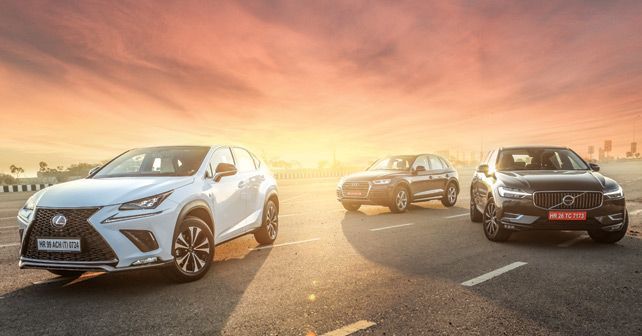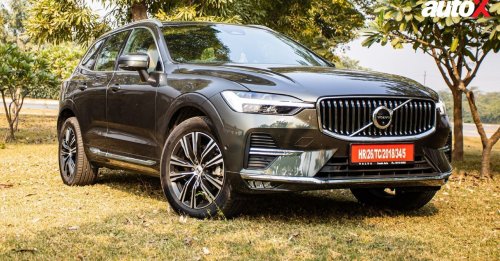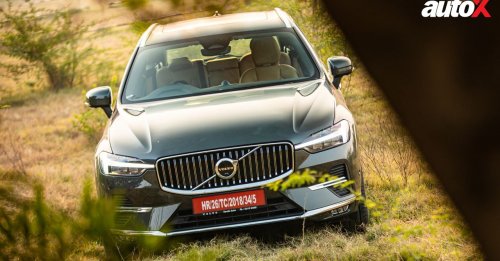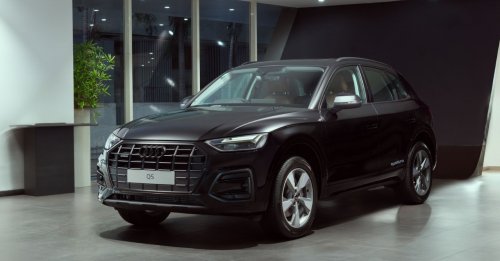The midsized luxury SUV segment, in the past few months, has become fiercely competitive with stellar products from multiple manufacturers. We’ve put together three of the latest – and best – products to see if we can pick a definitive winner in this three-way contest.
Pardon my rather churlish use of the French term for a three-way affair in the heading, but the fact remains that the mid-size luxury SUV segment is seeing a revival like never before. The recent generation of products from all three manufacturers – Audi, Lexus and Volvo – are absolutely stellar in their own right. And the fact that consumers worldwide seem to exhibit an insatiable appetite for SUVs only adds to their importance towards the manufacturer’s bottom line. So, this, in effect, is a straight out three-way battle.
Lineage, appearances and bottom lines
A noticeable point is that both the Audi Q5 and Volvo XC60 are the best-selling products for their respective brands worldwide. To put it in perspective, Audi sold over 1.6 million units of the last-generation Q5, making it the highest-selling Audi ever. Naturally, with that kind of volume potential, Lexus too is looking to make its mark with the NX – both in India and abroad.
What I like most about all three cars is that, in my opinion, they’re the ideal size for our roads. They are compact enough to be driven comfortably in our increasingly congested urban centers, and yet they have enough room for long road trips. Additionally, they’re also very easy to park, which is always an added benefit.
Stylistically, all three are completely unique and follow their own philosophies. Being an evolved version of the last-gen car, the Q5 doesn’t deviate far from its signature brand design – but, at the same time, there’s much more definition to its lines than before. There’s a much larger grille, but one that’s beautifully integrated into the design. And while it lends the Q5 presence, it doesn’t stand out for the wrong reasons. In profile, the Q5 looks even better with its definitive shoulder line – giving it character – while the large taillights add to the overall effect. I do think, however, that the 18-inch wheels of the Q5 look a tad small on the car – and perhaps an upgrade would add to the design. However, like I’ve said elsewhere in this issue, with the Q5’s design, Audi has played it safe – perhaps too safe – and I feel they could have taken a few more risks to make the design a tad edgier.
The Volvo XC60, on the other hand, is like a breath of fresh air in terms of design. Continuing the brand new, and rather stellar, design philosophy that started with the XC90, the XC60 is brilliantly proportioned with excellent design highlights. So, you get the ‘Thor’s Hammer’ headlights, sculpted sides and large taillights, along with a very balanced stance. All in all, the XC60 looks very avant-garde and minimal – you would expect nothing less from the Swedish brand of course.
The Lexus NX, on the other hand, is the result of a completely left-field approach. To use American baseball parlance, it really knocks the design out of the park. You get a massive spindle grille upfront, which stands out whether you like it or not. The sides have sharp lines and creases, and the rear features a sharply tapered tailgate along with large taillights. In monochrome white with black detailing, our test NX F Sport looked much like a ‘Stormtrooper’ – a very cool look indeed. I must add that, with its edgy design, of the three cars, it was the NX that manages to attract the largest number of eyeballs out on the streets.
Living quarters
Of course, given the segment they compete in, the interiors of all three cars are important to the extent that they could easily be the dealmaker or deal breaker for a potential customer. The Q5, once again, is the safest and the most conventional choice with its typical Audi interior. The result is excellent fit-and-finish and an updated entertainment system, featuring Apple CarPlay and Android Auto. It also has a gorgeous Virtual Cockpit system – a digital screen instead of the traditional dials – which is not only amazing to look at but also very intuitive to use. And, for me, it remains one of the major innovations in automotive technology in recent years. However, with its rather limited space, the Q5 is strictly a four-seater. Its huge transmission tunnel intrudes into the middle of the rear seat legroom, making a long ride for a fifth passenger not very comfortable. The boot, however, remains very usable and is of ideal capacity for a car of this size.
The Volvo XC60, on the other hand, has become a trendsetter as far as interior design and fit-and-finish are concerned. This newfound design language, along with phenomenal quality standards, means that there’s little in XC60’s interior that I can find fault with. The panel gaps, the material quality and the workmanship are simply flawless. Of course, I’m not as big a fan of the Sensus touchscreen entertainment system – I don’t like systems that make me take my eyes off the road for mundane tasks like setting the AC temperature. But, to give credit where credit’s due, it is great eye-candy and works exceedingly well. The Bowers and Wilkins sound system, meanwhile, delivers superb sound quality, and the space management is superbly executed – both in the interior and in the boot.
The NX too makes a definite mark in terms of its interior. The fit-and-finish is superb, and of particular interest is the massive sunroof that gives the roof an appearance of being virtually devoid of metal. Moreover, it makes the panoramic sunroofs of its competitors look exceedingly small in comparison. This lends the cabin a stupendous feeling of airiness, making it a good place to spend time in. The other outstanding feature of the Lexus NX is the high levels of sound deadening in the cabin. With the windows rolled up and doors closed, you’re so isolated from the outside world that you almost become oblivious to it. This intensifies the effect of its rather stellar sound system. However, the NX too has a couple of shortcomings. Its interior is slightly less spacious than both of its competitors, and, with a full-size spare wheel, it also has rather limited boot space.
Propulsion, emissions and riding along
As far as powertrains go, our trio features some safe choices, as well as an oddball choice amongst them. First up is the Audi Q5 with its ubiquitous 2-litre diesel engine paired to a 7-speed automatic and Quattro all-wheel drive. Producing 188bhp and 400Nm in this trim, the engine is quite refined and delivers power quite well. The 7-speed is a rather stellar gearbox, which delivers crisp shifts in both automatic mode and when shifted via the steering mounted paddles. However, the ride comfort is slightly tardy, as the standard steel suspension (there’s no air suspension here) offers a firm ride that can be annoying on broken roads.
The XC60 trumps the competition here, with its 2-litre diesel engine producing 232bhp and 480Nm of torque. Till recently, I could never have imagined that I would write an article about how a Volvo is the most powerful car in a leading trio – and that too by a big margin. But the world is changing, and perhaps this is the new normal. Paired to an 8-speed automatic and all-wheel drive, the XC60 is a breeze to drive irrespective of traffic conditions. The engine perfectly complements the size and the weight of the car and gives it fantastic performance – making it a great car to get behind the wheel of. Add to this, the standard-fit air suspension – the only one in its segment – and the Volvo makes for a more than satisfying driving experience. However, I must mention that on Indian roads some of the driving safety assist systems, such as Lane Keeping assist, can be quite annoying and need to be turned off for total piece of mind.
The Lexus has a slightly different configuration, with its Hybrid powerplant and e-CVT gearbox – but it does make a strong case for itself, especially with its EV-only capability. The refinement is excellent and the powertrain works well. However, it does show up its CVT lineage if you push hard. But, in all other situations, it’s the best CVT powertrain I’ve ever sampled. What still remains a novelty is the electric-only EV mode of the car, which is useful and feels very cool – especially when using the car at low speeds or in large car parks. It’s a cool feeling when you’re coasting along on nothing but battery power.
Embarrassment of riches
A choice between this melange of SUVs is rather problematic. To be absolutely honest, none of the three can be discarded – as they’re all very capable products in their own right. But, then again, somebody has to play the proverbial ‘Prem Chopra villain’ in the story and take tough calls. So, here goes my Prem Chopra verdict! The Audi Q5 is a great product that betters the offerings of its predecessor – it’s the perfect size, has excellent refinement, interior quality and, of course, the blue-chip Audi brand name. If you’re looking for a mid-size luxury SUV that everyone will recognise and acknowledge, you can’t go wrong with the Q5. However, on absolute terms, I think Audi has sold itself short and could have – and should have – taken more risks with the Q5’s styling to launch the brand into a further dimension. Also, its pricing vis-à-vis the XC60 doesn’t make it that attractive a proposition, given that the Volvo has more power and better equipment levels.
The Lexus NX 300h, on the other hand, is a completely left-field approach to the mid-size SUV segment. It’s the absolute antithesis of the Q5 – edgy, irreverent and unexpected. With a hybrid powertrain – which is not drab, and is rather fun to drive – the NX offers an option for the environmentally conscious that no other brand does. Pair this with excellent isolation from the outside world and the superb Lexus buying and owning experience, and the NX makes a very strong case for itself – no matter whether you like the Star Wars livery of our test car or not (hint: I love the white and black livery! Always wanted to be a Jedi…).
The only clear winner here, then, is the XC60 – and deservedly so! Volvo’s latest crop of cars have trumped virtually all of their competition – what the baseball loving Yanks would call a homerun – and the XC60 is no different. With great proportions and design details, the XC60 is a pleasure to drive and a great machine to spend time in. With these features, XC60 makes the strongest case for itself in this three-way battle. And, while both its competitors come very close to challenging it, neither offers the complete package that the XC60 does. In this case, then, it’s the Swedes that win the Battle of Trois.

- Lexus NX 300h
- Audi Q5
- Volvo XC60
Engine: 2,500cc / In-line Four-Cylinder / Atkinson cycle
Fuel: Petrol
Transmission: E-CVT / All-Wheel Drive
Power:194bhp @ 5,700rpm
Torque:210Nm @ 4,200-4,400rpm
Price: Rs.53.18-55.58 lakh (Ex-showroom)
X-factor: The Lexus will certainly get you noticed. And, since it’s a hybrid, you can highlight your green credentials too.
| Pros • Edgy design that gets attention • Hybrid means that it flies the green flag • Amazing isolation from the outside world | Cons • Petrol only • Boot space is a bit tight |
Engine: 1,968cc / In-line 4-Cylinder / Turbocharged
Fuel: Diesel
Transmission: 7-Speed S-Tronic / All-Wheel Drive
Power: 188bhp @ 3,800-4,000rpm
Torque: 400Nm @ 1,750-3,000rpm
Price: Rs.53.25 - 57.60 lakh (Ex-showroom)
X-factor: Everything you love about Audi in a near-perfect package.
| Pros • Blue-chip brand image • Safest choice of the three | Cons • Equipment count is low • Design could’ve been edgier |
Engine: 1,969cc / In-Line 4 Cylinders / 16 Valves / DOHC / Turbocharged
Fuel: Diesel
Power: 232bhp @ 4,000rpm
Torque: 480Nm @ 1,750-2,250rpm
Transmission: 8-speed Automatic / All-Wheel Drive
Price: Rs.55.90 lakh (Ex-showroom)
X-factor: Beautifully built and styled – inside, as well as out. And a joy to drive!
| Pros • Beautifully designed, inside and out • Great quality and equipment levels | Cons • Some driver aids can be very annoying on Indian roads • Touchscreen interface not ideal to fiddle with when driving |


























Write your Comment